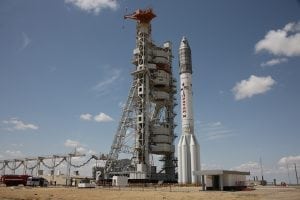[Via Satellite 05-18-2015] Following the May 16 Proton Breeze M launch failure that claimed Mexico’s Centenario satellite, all involved parties have begun efforts to identify the cause of the incident and understand its effects. The mission, conducted by International Launch Services (ILS), suffered a launch anomaly during the rocket’s third stage operations approximately 490 seconds after liftoff. The satellite, unable to reach orbit, was declared a loss.
The Centenario satellite was the second of three spacecraft in the Mexsat Satellite System for the Mexican Ministry of Communications and Transportation (SCT). The satellite system is designed for mobile voice and data services for government agencies, as well as improved access to telecommunications in remote parts of the country.
The launch mishap, coincidentally, occurred on the same day as last year’s Federal Proton failure that destroyed the Russian Satellite Communications Company’s (RSCC’s) Express AM4R satellite. Two Failure Review Oversight Boards (FROBs) will lead investigations into this year’s Proton anomaly. In an email to Via Satellite, ILS confirmed that Igor Komarov, head of the Russian Federal Space Agency Roscosmos, is leading as chairman of the Russian State Commission’s FROB, supported by Alexander Medvedev, deputy director of rocket manufacturer Khrunichev as deputy chairman of the commission. Additional representatives from the Board of the Military-Industrial Commission under the Government of the Russian Federation; customer representatives from Roscosmos and the Russian Defense Ministry; ACCD, and heads of branch institutes and enterprises from the nation’s rocket and space industry will also participate. ILS is forming a separate FROB of its own.
In a May 16 press conference, ILS VP of Sales James Kramer said that all future Proton launches are on hold while the investigation takes place.
“The state commission will go through a very methodical process of evaluating all of the flight telemetry data, and determine from the data analysis what is the most likely cause of the anomaly which caused the loss of the vehicle and the spacecraft,” he said.
Arianespace launched the first satellite in the Mexsat constellation, Bicentenario, in December 2012 aboard an Ariane 5 rocket. The third satellite, Morelos 3, is scheduled to launch this October aboard a Lockheed Martin Commercial Launch Services’ Atlas 5 vehicle.
Boeing Satellite Systems International’s President Mark Spiwak said during the press conference that the Morelos 3 satellite is in storage now, and that the company is ready to support launching at the earliest possible time. Boeing is the prime contractor for all three satellites. Subcontractor Orbital Sciences, now Orbital ATK, built the Bicentenario satellite on the GEOStar 2 platform, while Boeing built the other two Mexsat satellites on the 702 High Power (HP) bus.
Mexico’s Secretary of Communications and Transport, Gerardo Ruiz Esparza reiterated that despite the loss of a satellite, the ministry is confident in the path it chose to provide connectivity throughout the country.
“The benefit, as I said, is not so much being in the space age. I think the important thing is the service that these satellites will provide Mexicans [in order] to reach remote areas where when we face problems — these areas are virtually isolated. This is the latest technology, there’s no doubt about it. These are satellites with exceptional coverage — the most modern in the world. This must be a formula that Mexico embraces with all its risks because the telecommunications reform requires us to expand our coverage in the country,” he said, adding, “the Morelos 3 attends what the Centenario satellite would have covered.”
Mexico fully insured the Centenario satellite, along with the launch, meaning the ministry will not suffer a financial loss from the anomaly. Ruiz Esparza said the satellite cost approximately $300 million to build and $90 million to launch. SCT signed the agreement with ILS for the launch in 2012. Ruiz Esparza said the ministry would have incurred a $60 million capital loss for opting not to fulfill the contract with this launch provider.
With activity for Proton suspended again less than a year after returning to the market, customers awaiting launches with the vehicle will see delays. The most acutely impacted customer is Inmarsat, whose Ka-band High Throughput Satellite (HTS) Global Xpress (GX) constellation will now require more time to achieve full global coverage. According to Inmarsat, many customers are awaiting total coverage before committing to capacity agreements.
“This is the third time our Global Xpress program has suffered launch delays because of Proton launch failures,” Rupert Pearce, CEO of Inmarsat said in a May 18 statement. “Although in the past, Proton has returned to flight within a few months of a launch failure, it will not be possible to determine the length of the delay in the launch of I-5 F3 until the cause of the Centenario launch failure is established.”
The satellite operator expects the renewed delay will have a small negative effect on 2015 revenue and earnings, with any further impacts still too early to discern. A fourth GX satellite, I-5 F4, is scheduled for completion in mid-2016, with a potential SpaceX launch in the second half of 2016 should the company choose to orbit the spacecraft for either additional capacity, or a replacement for I-5 F3.
Inmarsat has suspended its guidance of an 8 to 12 percent Calculated Annual Growth Rate (CAGR) in wholesale Mobile Satellite Service (MSS) revenues over the 2014 to 2016 timeframe. The operator does still anticipate GX will deliver no less than $500 million of additional revenues by the fifth anniversary of the global launch of commercial GX services.
Other customers impacted by the launch anomaly include Intelsat, whose Intelsat 31 satellite was scheduled to launch on a Proton rocket during the first quarter of 2016, and RSCC’s Express AM8.
Veronica Magan contributed to this story.
The post Proton Anomaly Creates String of New Delays appeared first on Via Satellite.
http://www.satellitetoday.com/launch/2015/05/18/proton-anomaly-creates-string-of-new-delays/
